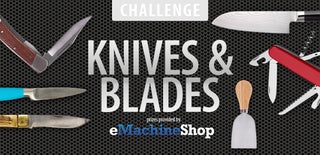Introduction: Batarang From a Saw Blade
Are you a Bruce Wayne on a budget with a crime to fight? If you have a few used up saw blades lying around, you can take grinder in hand and make yourself a few batarangs as you contemplate darkness, no parents, continued darkness, and more darkness.
This project assumes you don't have a metal bandsaw, plasma, laser or waterjet cutter, heat vision or any other method that makes hand cutting metal with a grinder obsolete. (We've been known to laser cut a throwing star or two.) The pleasure of this project is making something by hand.
Note: These can be made to be very sharp, so don't throw them at anyone. Cutting and throwing metal can be dangerous. Protect yourself. At a minimum, you should wear goggles. We wear full face shields whenever we work with the grinder or cut-off wheels, because although it's horrible to lose an eye, it's equally horrible to have a broken cut-off wheel fly into the side of your face. When we fight for justice, we wear spandex.
Step 1: Create Your Outline
I drew the outline in Illustrator using an image of the bat symbol from the Batman Begins logo. The ears are a little more pointy than they are on the one Bale makes in the movie, but if you read the excellent The Dark Knight Manual (a must-read for any Batman fan), you'll learn that each batarang was handmade for a different purpose.
Alternatively, you could draw something completely unrelated to a batarang and make a dogarang or a catarang. Whatever your superhero heart desires. There's plenty of room in the JLA for everyone.
If you want to make a batarang, I've included a PDF of the outline I created. Size it to whatever you like. We've made 4", 6" and even 7" batarangs. You're only limited by the size of your donor sawblade (and your skill with a cutoff wheel).
Attachments
Step 2: Gather Your Equipment and Supplies
This project requires a minimal amount of tools. In fact, you could do the whole thing with a rotary tool and a selection of cut-off wheels, grinding wheels, and sandpaper.
- Old saw blade (if you don't have a saw, you could always post on your local NextDoor or Freecycle and see if anyone has one lying around)
- Rotary tool (we use Dremel-brand, but any rotary tool will work)
- Cut-off wheels for rotary tool (if you bought a kit, chances are you have these, but we prefer the reinforced wheels)
- Angle grinder with cut off wheels (the one pictured is a Dewalt)
- Tabletop grinder (like this)
- Sandpaper / sanding block (for shining up the surface after)
- Acetone (for cleaning off any paint or marker that remains)
- Safety goggles or full face shield
- Gloves
- Strong desire for justice (just kidding, villians can make these too)
Step 3: Transfer Your Outline
The hardest part of this project is getting the outline onto the saw blade. We tried a bunch of different methods: Spray paint, Sharpie, lightly scoring the outline with the cut-off wheel, and gluing the profile onto the saw.
Spraypaint worked great for the initial outlining and gluing the profile on worked really well towards the end. Whatever method you choose, make sure you have a method for removing the marks after (acetone or grinding for the paint and sharpie). For the most part, we didn't have to do a lot of cleanup as we stayed pretty close to the lines. The heat of the grinder made the adhesive on the paper pop off fairly easily as well.
Step 4: Cut Out the Batarang
The easiest way to initially cut out your outline is to make a series of small cuts perpendicular to your art to create a series of thin tabs. Then, you break away those tabs with a pair of pliers. If a tab is too hard to break, go back in and cut it into two. In the more detailed areas, you'll want to make many thin tabs. You can also go back and tab areas after you've removed adjacent material.
The closer you can get to your final outline, the less work you'll have to do on the grinder.
Step 5: Detailing
Once you have the outline roughed in, you can go in with the grinder and create your final shape. Here, we're using a tabletop grinder, but you can also use the grinding stones on your rotary tool. They can be very helpful in getting in to the more detailed areas.
Don't worry about any heavy grind marks or mistakes. These are meant to look a little rough to accentuate their individuality. I actually prefer the batarangs with the circular saw marks on them to a highly polished batarang. They're one-time use items, after all.
Step 6: Finishing
We grind a bit of an edge onto them so they look more aggressive. Plus, if you're holding one in your batglove, you might need to do a little impromptu knife fighting with the baddies.
(The background in the first photo is a page from the aforementioned The Dark Knight Manual.)

Runner Up in the
Knives and Blades Challenge

Participated in the
Epilog Contest 8














